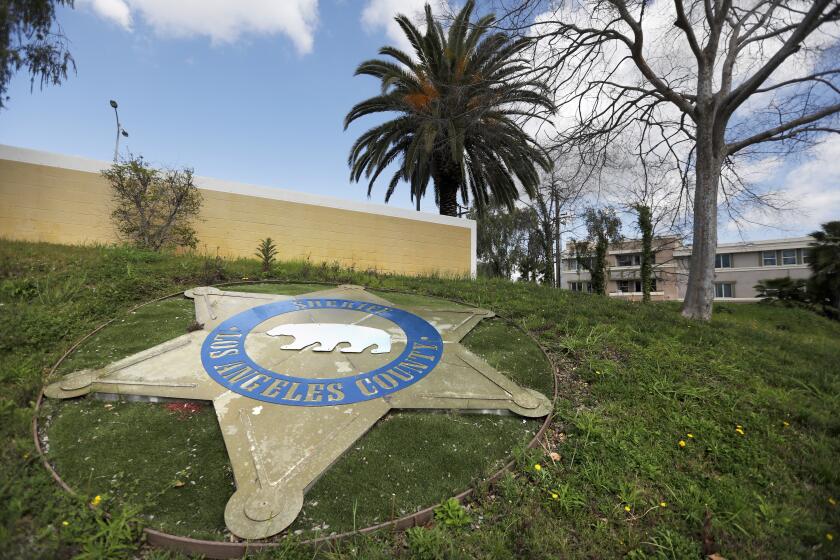L.A. Area Going to Extremes as the Middle Class Shrinks
A growing body of research shows Los Angeles to be a region of extreme polarization, where rich and poor live in separate neighborhoods, surrounded by others like themselves.
Demographers at Wayne State University in Detroit recently found Greater Los Angeles to be the most economically segregated region in the country. The study found only about 28% of its neighborhoods to be middle-class or mixedincome, compared with more than half of those in Nashville, Pittsburgh, Seattle and Portland, Ore.
More than two-thirds of L.A.-area residents live in neighborhoods that are solidly rich or poor, according to the analysis, which is based on 2000 census data. That share has been steadily growing for three decades, said one of the study’s authors, George Galster, a professor of urban affairs at Wayne State.
“The situation in L.A. is certainly at the extreme of American cities,” Galster said, adding that every one of the 100 metropolitan regions he looked at has grown more economically segregated over the last 30 years.
The trend parallels a well-documented loss of middleincome jobs in the United States over a generation. But the study found that middle-class neighborhoods are disappearing at a much faster rate than the comparable jobs.
Researchers attributed the faster pace to a kind of self-sorting. In other words, people are moving out of economically diverse neighborhoods to live in areas dominated by their own income group.
Los Angeles leads the trend.
“I think that poses real challenges to any society, politically and socially,” Galster said. “The fact that our society is moving to a situation where we don’t rub shoulders on a daily basis means that, more and more, people’s impressions of others will not be formed by personal experience but by images in the media.”
The study defined neighborhoods by residential census tracts, and defined middle income as between 80% and 120% of the metropolitan area’s median.
Los Angeles’ spot on the list can be explained, in part, by two factors that create bulges at each end of the economic spectrum: Large numbers of low-skilled immigrants earning low wages and a rarefied club of wealthy entertainment and business moguls.
Los Angeles County “has more billionaires than any other part of the country. It’s also the capital of the working poor,” said Peter Dreier, chairman of the Urban and Environmental Policy Program at Occidental College.
That wasn’t always the case. A generation ago, the region was a model for the post-World War II, middle-class lifestyle. High-wage manufacturing jobs were abundant, particularly in the aerospace industry. When the industry collapsed in the early 1990s, many middle-class residents left the region. In the meantime, large numbers of immigrants arrived seeking work.
Other changes mirrored national trends, including the development of large, similarly priced housing tracts outside city cores.
Now even the suburbs are growing apart. In a study conducted two years ago, Dreier and three colleagues found an increasing polarization of the rings surrounding U.S. cities.
“There are a growing number of wealthy suburbs, a growing number of poverty suburbs and an absolute decline in the number of middle-class suburbs,” he said.
Los Angeles’ suburbs also were among the nation’s most extreme. Only suburbs of Phoenix and Palm Beach, Fla., were more polarized, the researchers found.
Both reports on geographic polarization were released by the Washington, D.C.,-based Brookings Institution.
Alan Berube, a Brookings urban affairs specialist, said the pulling apart of rich and poor has immediate and tangible effects. For one thing, it can diminish choices and raise prices for everyone.
“The retailers in the two neighborhoods are very different,” he said. “It’s the difference between a Whole Foods and a corner grocer, or Citibank and the local check casher. They’re not competing, and in the end, you have higher prices for all basic goods and services.”
More broadly, Berube maintained, the shrinking of mixed or middle-income neighborhoods limits the ability of low-income residents to move up economically without leaving the region. It can even contribute to civic instability.
“People in the middle are an important social glue for a city,” he said. “To some extent, they serve to mediate the interests of low-income versus high-income, to help forge compromise.”
Dreier and Galster said government intervention is needed to reverse the trend.
In metropolitan regions that are continuing to grow, such as Los Angeles, they advocated a requirement that developers build a mix of housing, including affordable units for low-income residents.
Known as “inclusionary” housing, that tool has been adopted by dozens of California cities. But in Los Angeles it has been successfully opposed by business groups that have argued it would discourage developers from building in the city at all.
As an alternative, Los Angeles City Council members this month endorsed a proposal to ask voters to approve a $1-billion housing bond, to be financed through future property taxes.
The proposed measure, backed by business leaders and housing advocates alike, probably will appear on the November ballot. The money would be used to build a range of housing, including low-rent apartments, as well as to subsidize home loans for teachers, police officers and other essential workers.
It’s a start, said Dan Flaming, president of the Los Angeles-based Economic Roundtable, which conducts economic and demographic research for local government and private groups. “But by itself, it doesn’t change the problem.”
For several years, Flaming has documented the loss of middle-class jobs in the region, as well as the rise of the lowpaying informal economy. Using 2004 data, Flaming found that 15% of households in the county earned less than $15,000 a year, accounting for 2% of the area’s income. At the same time, 7% of households earned more than $150,000, accounting for 27% of the county’s total income.
Households earning the median range, between $45,000 and $50,000, made up one of the smallest segments of the population, less than 5%. Flaming calls it the vanishing middle.
“For 15 years, we’ve followed a dual-growth path, with a set of businesses generating high-wage jobs, and a rapidly expanding informal economy offering low-wage jobs,” Flaming said. “To change that dynamic, the business trajectory has to be replaced by something else. Can we transform these low-wage jobs to better-paying jobs? Can we get other sectors of the economy to grow, creating middle-wage jobs?”
*
(BEGIN TEXT OF INFOBOX)
The shrinking middle
Neighborhoods in the 100 largest U.S. metropolitan areas grew more economically segregated during the last 30 years. Los Angeles was the most polarized, with less than one-third of its neighborhoods middle-class.
10 most populous metropolitan areas,* by percent of neighborhoods that are middle-income:
*--* Metropolitan National Middle Lower Higher Areas rank** income income income Boston, MA-NH 43 44.5% 28.8% 26.7% Detroit 51 42.1 32.3 25.6 Philadelphia, PA-NJ 61 40.7 28.8 30.5 Washington, DC- MD-VA-WV 66 39.8 32.7 27.6 Atlanta 81 37.4 36.3 26.3 Chicago 84 36.4 37.1 26.5 Dallas 95 31.3 39.2 29.5 Houston 97 30.0 39.7 30.3 New York 99 29.6 34.5 35.9 Los Angeles, Long Beach 100 28.3 37.3 34.4
*--*
Note: The study’s definition of “neighborhood” is based on census tracts.
* U.S. Census Bureau Metropolitan Statistical Areas and Primary Metropolitan Statistical Areas
** Among the 100 most populous U.S. metropolitan areas
Sources: Brookings Institution, Census 2000
More to Read
Start your day right
Sign up for Essential California for news, features and recommendations from the L.A. Times and beyond in your inbox six days a week.
You may occasionally receive promotional content from the Los Angeles Times.






